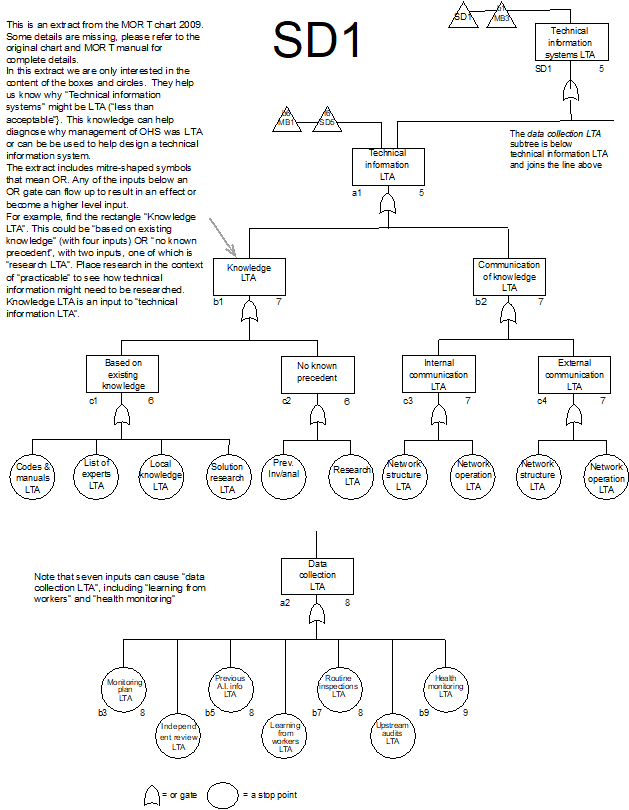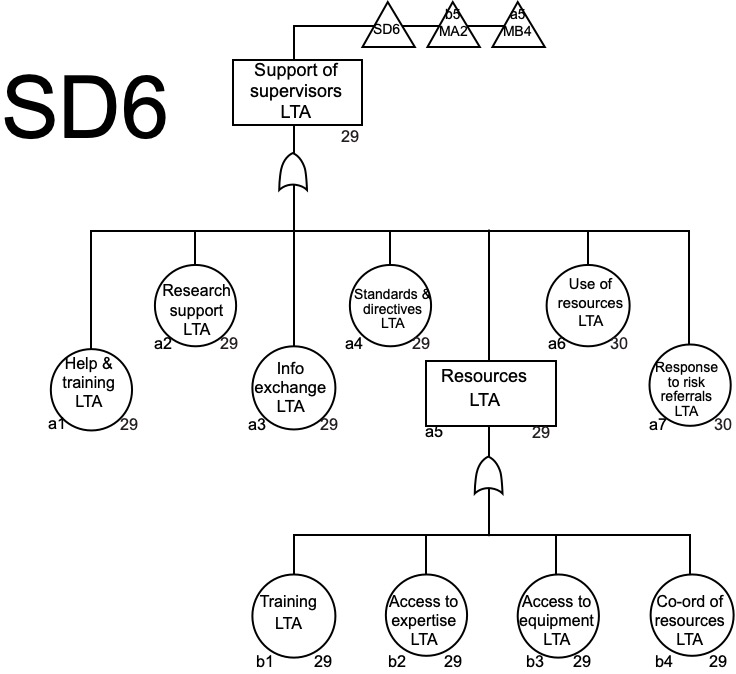8 Support for an OHSMS
8.1 Chapter overview
Cross-reference to ISO31000; ISO45001; Annex SL clause 7; clauses 7 and 8 in management system standards; and SafePlus requirements (section 2.2.5).
Definitions of italicised terms are in the Glossary.
Check for key readings, webinars, interviews, and videos for other resources.
Relevant law
- Health and Safety at Work Act 2015
- Health and Safety at Work (Worker Engagement, Participation, and Representation) Regulations 2016
- Health and Safety at Work (General Risk and Workplace Management) Regulations 2016
- Health and Safety at Work (Major Hazard Facilities) Regulations 2016
Key questions
What is or will be the impact of artificial intelligence on the business?
If risk is the “effect of uncertainty on objectives“:
- what are the operational or tactical objectives of the organisation, activity, system, or item?
- what are the uncertainties about achieving the objectives?
- how do or will those uncertainties affect achievement of the operational objectives?
- what support is needed to help eliminate or minimise such uncertainties?
Useful management techniques
The following management techniques may help identify support necessary to eliminate or minimise uncertainty and its effect on objectives.
- Fishbone or Ishikawa diagram (see section 21.3.12)
- Flowcharting or process mapping (see section 21.3.13)
- HAZOP analysis (see section 21.3.15)
- Hierarchical task analysis (see section 21.3.17)
- MORT chart (see section 21.3.24).
Annex A.7 ISO45001
Please read Annex A.7 in ISO45001 to see the range of support a PCBU may need to provide to implement an effective occupational health and safety management system. If using the MORT chart, a few key issues are expanded in the following pages. Also consider document usability (Hofer, 2020), document management (ISO/N1286, 2015) and OHS policy writing (Hosking, 2018).
8.2 Awareness
A study by Breakwell & Petts (2001) “aimed to identify what additional research is needed to establish what approaches can be used to initiate greater awareness and activity concerning health and safety in those segments of the public that are difficult to access (DAPs). It reviewed approaches that theoretically could be used and those currently used; identifying how effective they are and where there are uncertainties about their impact”. This research might be applicable in sectors where a PCBU owes a duty of care to hard-to-reach people.
8.3 Resources
ISO45001 clause 7.1 identifies a range of resources needed to establish and maintain an occupational health and safety management system. One that may be overlooked is technical information, as summarised in the MORT chart.

Source: Adapted with permission from NRI (2009a). For use with the Management Oversight and Risk Tree analytical logic diagram.
Support of supervisors as a control
Support of supervisors (including resources available to them) is a control. It might be LTA as shown in Figure 26, subtree SD6 in the MORT chart.

Source: Adapted from NRI (2009b). For use with the Management Oversight and Risk Tree analytical logic diagram.
8.4 Competence
Competence in major hazard facilities was researched by Wright et al. (2003, p. 1) who showed that duty holders under the UK Control of Major Accident Hazard Regulations 1999 (COMAH) recognise the importance of experienced and competent staff but may make untested assumptions about their competence. Wright et al. provided (1) a review of the then current practice, (2) a view of what comprised good practice in the field of competence assessment in relation to major accident prevention, and (3) a body of advice, checklists, and examples of assessment. Some of their research is relevant to major hazard facilities and other high-risk industries.
Three cases
In an English common law case Gibson v Skibs A/S Marina, Justice Cantley (Gibson v Skibs A/S Marina, 1966) asked: “Who is ‘a competent person’ for the purpose of such an inspection [of lifting gear under the British Docks Regulations 1934]? This phrase is not defined. I think that it is obviously to be taken to have its ordinarily meaning of a person who is competent for the task. I think that a competent person for this task is a person who is a practical and reasonable man, who knows what to look for and knows how to recognise it when he sees it”. For complex activities, plant, or systems, knowing what to look for and how to recognise it might require specialist qualifications demonstrating necessary knowledge.
In an earlier English common law case (Brasier v Skipton Rock Co (Brasier v Skipton Rock Co., 1962)) Justice Winn noted the “lack of a definition of ‘competent’ in the [British Quarries (General) Regulations 1956]” Regulations and was “not prepared to hold either that ‘competent’ means the most competent person available to the owners of the quarry or their manager, or that it means that [the competent person] shall be so competent that he never makes a mistake. In my judgement, it means a man who, on fair assessment of the requirements of the task, the factors involved, the problems to be studied and the degree of risk danger implicit, can fairly, as well as reasonably, be regarded by the manager, and in fact is regarded at the time by the manager, as competent to perform such an inspection”.
The Brasier v Skipton Rock case has some similarities to a District Court case when a quarry manager was found to have the necessary competence to assess risk in a sand quarry (WorkSafe NZ v Mount Somers Sand Ltd, 2021). In this case, WorkSafe initiated action after two inspectors had spent 15 minutes on site. The defence called an expert witness who had professional qualifications and who had spent adequate time inspecting the quarry.
8.5 Communication and engagement
Examples of effective communication and engagement are in reports on the London Olympics construction project (Cheyne et al., 2012; Healey & Sugden, 2012; Lucy et al., 2011).
8.5.1 Documented information
When ISO9001 was revised two key objectives were:
a) to develop a simplified set of standards that will be equally applicable to small as well as medium and large organizations, and
b) for the amount and detail of documentation required to be more relevant to the desired results of the organization’s process activities.
Publicly available guidance on “the amount and detail of documentation required” (ISO/N1286, 2015) was also published and can be used in the development and maintenance of other management systems. Application of that guidance might also enable “decluttering” (Rae et al., 2018) or complexity reduction.
8.6 Identifying what’s missing in the management system
The purpose of a management system is to help a PCBU achieve its objectives or goals. For work health and safety identify a specific goal that is Specific, Measurable, Achievable, Realistic, and Timely – SMART. Mapping what is already in a management system and identifying what is missing will help develop an action plan for improvement. This can be done using Fishbone or Ishikawa analysis (section 21.3.12).
8.7 Chapter summary
This chapter has outlined some of the resources that might be needed to establish and maintain an occupational health and safety management system.
8.8 References used in this chapter
Brasier v Skipton Rock Co. [1962].
Breakwell, G., & Petts, J. (2001). Stakeholder participation methods: Scoping study [Contract Research Report CRR317]. Health and Safety Executive, Buxton. https://www.hse.gov.uk/research/publish.htm
Cheyne, A., Hartley, R., Gibb, A., et al. (2012). Talk the talk – walk the walk: An evaluation of Olympic Park safety initiatives and communication [Research Report 12.1]. IOSH Publishing Ltd, Wigston. http://www.iosh.co.uk/olympicpark
Gibson v Skibs A/S Marina [1966].
Healey, N., & Sugden, C. (2012). Safety culture on the Olympic Park [Research Report RR0942]. Health and Safety Executive, Buxton. https://www.hse.gov.uk/research/publish.htm
Hofer, K. (2020). Usability of procedures. In Core Body of Knowledge for the Generalist OHS Professional. Australian Institute of Health and Safety. https://www.ohsbok.org.au/
Hosking, L. (2018, March). Foundation documents: policy writing. IOSH Magazine.
ISO/N1286. (2015). Guidance on the requirements for Documented Information of ISO 9001:2015 [Guidance Note ISO/TC 176/SC2/N1286]. International Standards Organization, Geneva. https://www.iso.org/home.html
Lucy, D., Tamkin, P., Tyers, C., et al. (2011). Leadership and worker involvement on the Olympic Park [Research Report RR0896]. Health and Safety Executive, Buxton. https://www.hse.gov.uk/research/publish.htm
NRI. (2009a). MORT – Management Oversight and Risk Tree [Report NRI2-2009-EN]. Noordwijk Risk Initiative Foundation, Delft. www.nri.eu.com
NRI. (2009b). MORT – Management Oversight and Risk Tree [Chart NRI2-2 (2009)]. Noordwijk Risk Initiative Foundation, Delft. www.nri.eu.com
Rae, A., Provan, D., Weber, D. E., et al. (2018). Safety clutter: the accumulation and persistence of ‘safety’ work that does not contribute to operational safety. Policy and Practice in Health and Safety, 16(2), 194-211. https://doi.org/10.1080/14773996.2018.1491147
WorkSafe NZ v Mount Somers Sand Ltd [2021] NZDC16270 Ashburton District Court.
Wright, M., Turner, D., & Horbury, C. (2003). Competence assessment for the hazardous industries [Research Report RR0086]. Health and Safety Executive, Buxton. https://www.hse.gov.uk/research/publish.htm

